Themed collection Spectroscopy of Inorganic Excited States

Spectroscopy of inorganic excited states
Welcome to this Dalton Transactions themed issue on Spectroscopy of Inorganic Excited States.
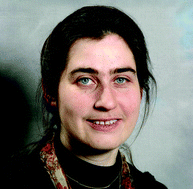
Dalton Trans., 2014,43, 17565-17566
https://doi.org/10.1039/C4DT90185A
A novel aspect of spectroscopy for porphyrinic compounds under magnetic fields
This perspective offers an overview of the recent studies on the Kerr effects, time-resolved electron paramagnetic resonance (TREPR) and magneto-chiral dichroism (MChD) of a range of porphyrinic compounds.
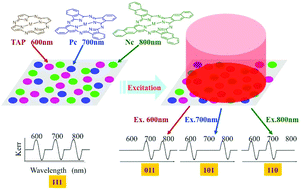
Dalton Trans., 2014,43, 17596-17605
https://doi.org/10.1039/C4DT01428F
Ultrafast photophysical processes for Fe(III)-carboxylates
Recent works devoted to the investigation of ultrafast processes for several environmentally important Fe(III) carboxylates were observed and discussed.
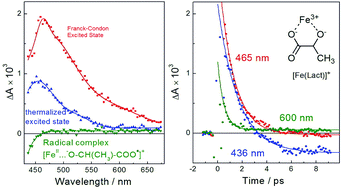
Dalton Trans., 2014,43, 17590-17595
https://doi.org/10.1039/C4DT01419G
Transient 2D-IR spectroscopy of inorganic excited states
This Perspective discusses applications of ultrafast transient 2D-IR spectroscopy methods to the study of inorganic excited states.
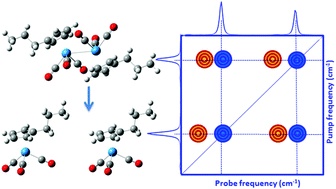
Dalton Trans., 2014,43, 17578-17589
https://doi.org/10.1039/C4DT01410C
Excited state potential energy surfaces and their interactions in FeIV![[double bond, length as m-dash]](https://www.rsc.org/images/entities/char_e001.gif) O active sites
O active sites
Excited states and their interactions in low-spin and high-spin non-heme ferryl active sites are probed by low-temperature magnetic circular dichroism spectroscopy providing mechanistic insight into enzymatic functions.
![Graphical abstract: Excited state potential energy surfaces and their interactions in FeIV [[double bond, length as m-dash]] O active sites](/en/Image/Get?imageInfo.ImageType=GA&imageInfo.ImageIdentifier.ManuscriptID=C4DT01366B&imageInfo.ImageIdentifier.Year=2014)
Dalton Trans., 2014,43, 17567-17577
https://doi.org/10.1039/C4DT01366B
Accurate yet feasible computations of resonance Raman spectra for metal complexes in solution: [Ru(bpy)3]2+ as a case study
Herein we present a new and promising approach for the high-resolution modeling of vibrational resonance Raman spectra of metal complexes in solution.
![Graphical abstract: Accurate yet feasible computations of resonance Raman spectra for metal complexes in solution: [Ru(bpy)3]2+ as a case study](/en/Image/Get?imageInfo.ImageType=GA&imageInfo.ImageIdentifier.ManuscriptID=C4DT02151G&imageInfo.ImageIdentifier.Year=2014)
Dalton Trans., 2014,43, 17610-17614
https://doi.org/10.1039/C4DT02151G
Study of picosecond processes of an intercalated dipyridophenazine Cr(III) complex bound to defined sequence DNAs using transient absorption and time-resolved infrared methods
Excited-state quenching of DNA intercalated [Cr(phen)2(dppz)]3+ by guanine proceeds by rapid forward and back electron transfer of <3 ps.
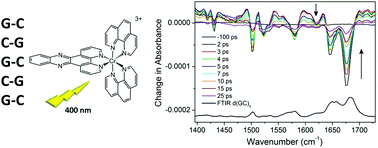
Dalton Trans., 2014,43, 17606-17609
https://doi.org/10.1039/C4DT01989J
Electron transfer rate modulation in a compact Re(I) donor–acceptor complex
Excitation of the vibrational modes at the bipyridine ligand results in modulation of the electron transfer rate between the electron donating and accepting ligands in a Re(I) complex.
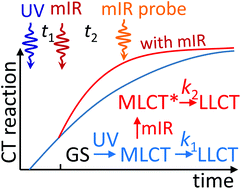
Dalton Trans., 2015,44, 8609-8616
https://doi.org/10.1039/C4DT02145B
Electron transfer dynamics and excited state branching in a charge-transfer platinum(II) donor–bridge-acceptor assembly
Charge-transfer excited state branches over 3 pathways on the timescale up to 14 ps.
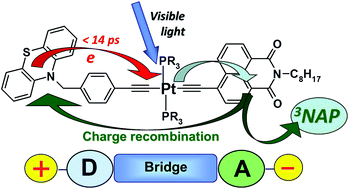
Dalton Trans., 2014,43, 17677-17693
https://doi.org/10.1039/C4DT01682C
Spectroelectrochemical identification of charge-transfer excited states in transition metal-based polypyridyl complexes
In this report, we demonstrate how spectroelectrochemistry can be used to help characterize dynamics associated with charge-transfer excited states of transition metal-based chromophores as measured by ultrafast electronic absorption spectroscopy.
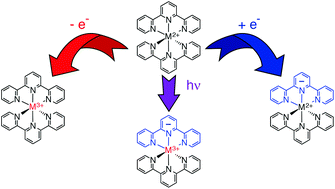
Dalton Trans., 2014,43, 17635-17646
https://doi.org/10.1039/C4DT02849J
The effect of thermal motion on the electron localization in metal-to-ligand charge transfer excitations in [Fe(bpy)3]2+
Accurate electronic structure calculations of the lowest excited states have been performed on twenty snapshots of a molecular dynamics simulation of [Fe(bpy)3]2+ dissolved in water.
![Graphical abstract: The effect of thermal motion on the electron localization in metal-to-ligand charge transfer excitations in [Fe(bpy)3]2+](/en/Image/Get?imageInfo.ImageType=GA&imageInfo.ImageIdentifier.ManuscriptID=C4DT02294G&imageInfo.ImageIdentifier.Year=2014)
Dalton Trans., 2014,43, 17838-17846
https://doi.org/10.1039/C4DT02294G
Spectroscopic effects resulting from interacting singlet and triplet excited states: vibronic structure involving the O–H stretching mode in d–d absorption bands of Ni(H2O)62+
Spin–orbit coupling between metal-centered electronic states can lead to absorption spectra with vibronic structure involving ligand-centered vibrational modes, as theoretically analyzed for Ni(H2O)62+.
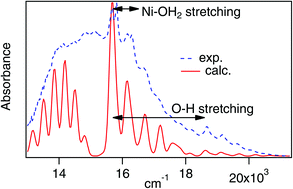
Dalton Trans., 2014,43, 17864-17870
https://doi.org/10.1039/C4DT01979B
Temperature dependent iodide oxidation by MLCT excited states
Temperature dependent excited state iodide oxidation by two heteroleptic Ru polypyridyl compounds was quantified for the first time.
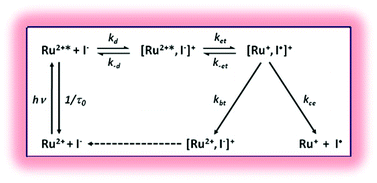
Dalton Trans., 2014,43, 17856-17863
https://doi.org/10.1039/C4DT01683A
Ultrafast spectroscopy and structural characterization of a photochromic isomerizing ruthenium bis-sulfoxide complex
Irradiation of [Ru(bpy)2(bpSOp)](PF6)2 (where bpy is 2,2′-bipyridine and bpSOp is 1,3-bis(phenylsulfinyl)propane) results in the formation of two new isomers, namely the S,O- and O,O-bonded species.
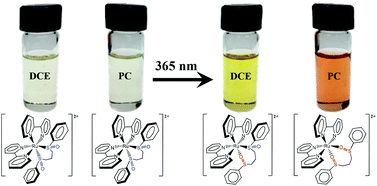
Dalton Trans., 2014,43, 17847-17855
https://doi.org/10.1039/C4DT01402B
A strong steric hindrance effect on ground state, excited state, and charge separated state properties of a CuI-diimine complex captured by X-ray transient absorption spectroscopy
Steady-state and transient structures of a copper diimine dye sensitizer on TiO2 nanoparticles undergoing photoinduced interfacial electron transfer are determined.
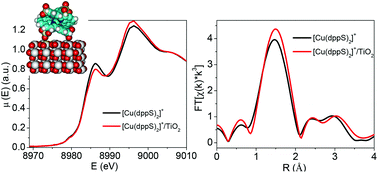
Dalton Trans., 2014,43, 17615-17623
https://doi.org/10.1039/C4DT02046D
Synthesis and photoinduced electron transfer in platinum(II) bis(N-(4-ethynylphenyl)carbazole)bipyridine fullerene complexes
Photoinduced electron transfer reactions in platinum(II) donor–chromophore–acceptor triads were investigated in detail by transient absorption spectroscopy.
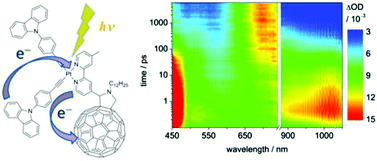
Dalton Trans., 2014,43, 17624-17634
https://doi.org/10.1039/C4DT01397B
Photophysics and non-linear absorption of Au(I) and Pt(II) acetylide complexes of a thienyl-carbazole chromophore
Carbazole oligomers with Pt(II)- and Au(I)-acetylide end units exhibit non-linear absorption due to instantaneous two-photon absorption combined with triplet–triplet absorption.
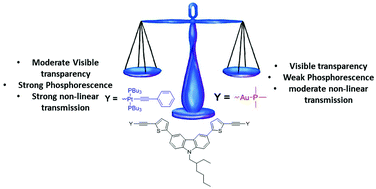
Dalton Trans., 2014,43, 17721-17728
https://doi.org/10.1039/C4DT02123A
A little spin on the side: solvent and temperature dependent paramagnetism in [RuII(bpy)2(phendione)]2+
Magnetometry, 1H-NMR, EPR and substituent effects are used to explain solvent and temperature dependent paramagnetism in [RuII(bpy)2(phendione)](PF6)2.
![Graphical abstract: A little spin on the side: solvent and temperature dependent paramagnetism in [RuII(bpy)2(phendione)]2+](/en/Image/Get?imageInfo.ImageType=GA&imageInfo.ImageIdentifier.ManuscriptID=C4DT01868K&imageInfo.ImageIdentifier.Year=2014)
Dalton Trans., 2014,43, 17729-17739
https://doi.org/10.1039/C4DT01868K
Modified bibenzimidazole ligands as spectator ligands in photoactive molecular functional Ru-polypyridine units? Implications from spectroscopy
The contribution of different protected bibenzimidazole ligands to the excited state in Ru-complexes has been evidenced using theory-aided resonance-Raman spectroscopy.
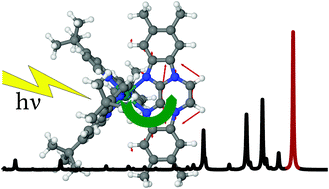
Dalton Trans., 2014,43, 17659-17665
https://doi.org/10.1039/C4DT01399A
Isomerization initiated by photoinduced ligand dissociation in Ru(II) complexes with the ligand 2-p-tolylpyridinecarboxaldimine
The photoinduced ligand exchange and isomerization of ruthenium(II) complexes proceed via a common intermediate for all isomers.
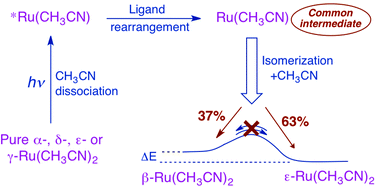
Dalton Trans., 2014,43, 17828-17837
https://doi.org/10.1039/C4DT02016B
Picosecond time-resolved infrared spectroscopy of rhodium and iridium azides
Ultrafast photochemical processes induced in the transition metal azido complexes Rh(Cp*)(N3)2(PPh3) and Ir(Cp*)(N3)2(PPh3) upon laser excitation at 266 nm and 400 nm were elucidated by picosecond time-resolved infrared spectroscopy and density functional theory.
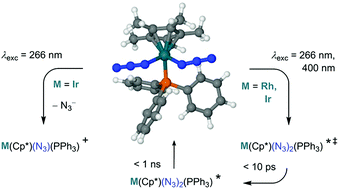
Dalton Trans., 2014,43, 17694-17702
https://doi.org/10.1039/C4DT02097A
Femtosecond spectroscopy and TD-DFT calculations of CuCl42− excited states
Photoinduced processes of tetrahexylammonium tetrachlorocuprate [(C6H13)4N]2CuIICl4 in chloro-organic solvents were investigated by steady state photolysis and femtosecond transient absorption spectroscopy, as well as TD-DFT calculations of excited terms.
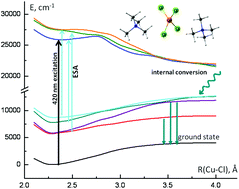
Dalton Trans., 2014,43, 17820-17827
https://doi.org/10.1039/C4DT01409J
Spin–orbit effects in square-planar Pt(II) complexes with bidentate and terdentate ligands: theoretical absorption/emission spectroscopy
Theoretical “spin-free” (in black) and “spin–orbit” (in red) absorption spectra of [Pt(tpy)Cl]+ and electronic densities characterizing the main intense bands MLCT/XLCT at 384 nm, and MLCT/LC at 326 nm and 250 nm (the experimental spectrum is shown in the inset).
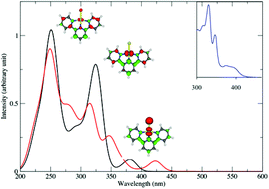
Dalton Trans., 2014,43, 17806-17819
https://doi.org/10.1039/C4DT01822B
Ultrafast electronic and vibrational relaxations in mixed-ligand dithione–dithiolato Ni, Pd, and Pt complexes
Excitation of Pt, Pd, Ni dithione–dithiolates triggers fs solvation-driven charge redistribution and 6 ps ISC.
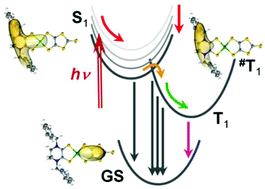
Dalton Trans., 2014,43, 17666-17676
https://doi.org/10.1039/C4DT01955E
Excited state evolution towards ligand loss and ligand chelation at group 6 metal carbonyl centres
Picosecond time-resolved infrared measurements and quantum chemical calculations provide insight into the photophysics and photochemistry of (η6-arene)Cr(CO)3 complexes.
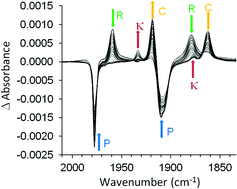
Dalton Trans., 2014,43, 17797-17805
https://doi.org/10.1039/C4DT01544D
Stretching the phenazine MO in dppz: the effect of phenyl and phenyl–ethynyl groups on the photophysics of Re(I) dppz complexes
Dppz complexes with extended conjugation show π,π* and MLCT excited states in solution. Raman spectral features for the short-lived π,π* state are observed in single-colour transient experiments.
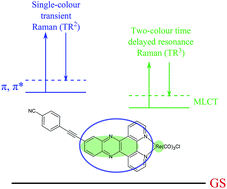
Dalton Trans., 2014,43, 17775-17785
https://doi.org/10.1039/C4DT01415D
Sn(IV) Schiff base complexes: triplet photosensitizers for photoredox reactions
We present the synthesis and characterization of a series of four fluorescent Sn(IV) Schiff base complexes, which also possess long-lived triplet excited states.
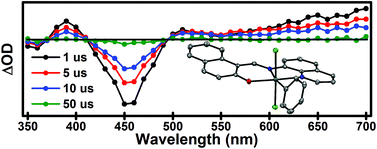
Dalton Trans., 2014,43, 17754-17765
https://doi.org/10.1039/C4DT01427H
Light-induced spin-state switching in the mixed crystal series of the 2D coordination network {[Zn1−xFex(bbtr)3](BF4)2}∞: optical spectroscopy and cooperative effects
Strong cooperative interactions result in light-induced bistability between the high-spin and the low-spin state.
2}∞: optical spectroscopy and cooperative effects](/en/Image/Get?imageInfo.ImageType=GA&imageInfo.ImageIdentifier.ManuscriptID=C4DT01728E&imageInfo.ImageIdentifier.Year=2014)
Dalton Trans., 2014,43, 17786-17796
https://doi.org/10.1039/C4DT01728E
Molecular excitons in a copper azadipyrrin complex
Exciton coupling is applied for the first time to successfully explain the excited-state structure of metalloazadipyrrins.
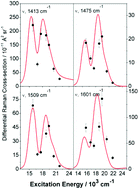
Dalton Trans., 2014,43, 17746-17753
https://doi.org/10.1039/C4DT01588F
Femtosecond spectroscopy of the dithiolate Cu(II) and Ni(II) complexes
Femtosecond spectroscopy was applied to study the ultrafast dynamics for the excited states of dithiolate Cu(II) and Ni(II) complexes.
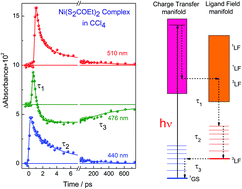
Dalton Trans., 2014,43, 17766-17774
https://doi.org/10.1039/C4DT01407C
Pyridyl-1,2,4-triazole diphenyl boron complexes as efficient tuneable blue emitters
1,2,4-Triazole based boron complexes are readily tunable blue emitters.
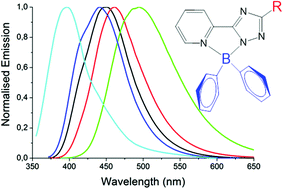
Dalton Trans., 2014,43, 17740-17745
https://doi.org/10.1039/C4DT01393J
Photophysical properties of an unusual bichromophoric species constructed from a cyclometalated Pt(II) chromophore and a blue Bodipy-acetylacetonate species
Complex 1 exhibits a formally forbidden energy transfer from the metal-based triplet to the fluorescent Bodipy singlet state.
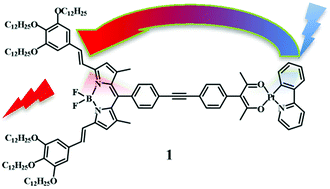
Dalton Trans., 2014,43, 17647-17658
https://doi.org/10.1039/C4DT01127A
Photophysical properties of trans-platinum acetylide complexes featuring N-heterocyclic carbene ligands
Platinum acetylide complexes featuring NHC-carbene ligands show enhanced photophysical properties relative to complexes with phosphine ligands.
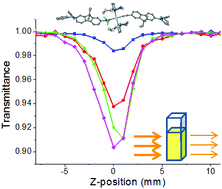
Dalton Trans., 2014,43, 17712-17720
https://doi.org/10.1039/C4DT01520G
Electronic excited states of chromium and vanadium bisarene complexes revisited: interpretation of the absorption spectra on the basis of TD DFT calculations
The influence of the (η6-arene)2M (M = Cr, V, Cr+) composition on parameters of intravalency and Rydberg transitions is explained on the basis of time-dependent DFT.
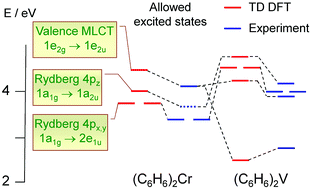
Dalton Trans., 2014,43, 17703-17711
https://doi.org/10.1039/C4DT01481B
About this collection
Interrogation of excited states is a constantly developing field, reaching out to ever more detailed studies of matter, broadening energy and time scales. Building on advances in light sources and detection technologies, new methods are emerging which combine several advanced techniques in a single study.
Guest Edited by Dr Julia Weinstein (The University of Sheffield), this themed issue aims to provide an understanding of inorganic excited states and highlight recent developments in the field.